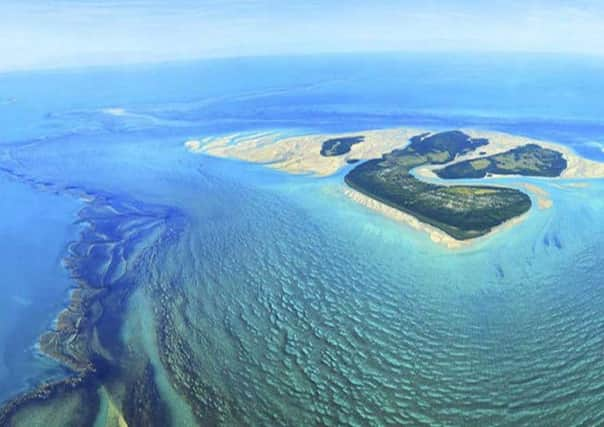Lime juice and soup made from preserved meat were the cures


The 50-mile-long Montgomery Reef on the rugged, remote and breathtakingly beautiful Kimberley Coast, was explored and mapped by Admiral Phillip Parker King in 1821.
Andrew Montgomery, previously a convict-ship’s surgeon, was King’s expedition surgeon.
Advertisement
Hide AdAdvertisement
Hide AdBorn in Enniskillen around 1792, Montgomery departed England for Australia on August 18, 1820 on the convict-ship Elizabeth.
Though there was a lot of sickness during the 135-day voyage, he was evidently a proficient physician because all of the approximately 200 convicts (all men), guards (and their wives and children), crewmen and passengers arrived in Port Jackson in Australia on 31 December 1820.
Montgomery kept a medical journal and daily diary which make intriguing reading.
Various publications about convict-ships refer to Montgomery and he’s mentioned in several old travel books and more up-to-date tourism brochures about the reef and islands that are named after him.
Advertisement
Hide AdAdvertisement
Hide AdMore information, particularly a portrait, would be greatly appreciated via the address on this page.
The convict-ship Elizabeth that first brought Montgomery to Australia was built at Chepstow in 1809.
The 170 all-male convicts, with sentences ranging from six years to life, were divided into six groups.
Montgomery’s diary records that “a well-behaved man” was put in charge of each group “responsible for the behaviour, cleanliness of the prisoners and accountable for the clothing and bedding.”
Advertisement
Hide AdAdvertisement
Hide AdElizabeth’s Irish Surgeon was responsible for the health and wellbeing of men of all ages and backgrounds.
Fourteen-year-old George Keene from Gloucester was sentenced to transportation for life for shoplifting.
Michael Wright, a 23-year-old Newcastle man “of slender build, sallow complexion, light brown hair and blue eyes”, was ordered to two years in a penal settlement for stealing pigs.
John Hughes was a 40-year-old former Welsh labourer.
George Hindson, a clerk from Lincoln, was sentenced to seven years’ transportation for felony.
John Nash was a 35-year-old milkman.
Advertisement
Hide AdAdvertisement
Hide AdThe boys were separated from the men and “a well- conducted man was placed over them as schoolmaster.”
The young lads made diligent students.
Montgomery noted that they “paid such attention to the schoolmaster that many of the boys who did not know the alphabet when they came on board could read and write when they disembarked at Port Jackson.”
There were also classes for the older convicts “and several men paid great attention to reading, writing and arithmetic.”
Religious services were held on the Quarter Deck every Sunday when the weather would permit “and at such times” Montgomery recounted “the guards were always under arms on the Poop deck”!
Advertisement
Hide AdAdvertisement
Hide AdEven though he gave the convicts, crew and guards “a daily allowance of lemonade” rampant scurvy broke out after five or six weeks at sea.
Montgomery asked the Elizabeth’s Captain William Ostler to stop off for a week at Rio where local fresh food cured the scurvy.
No sooner had they set sail again when a second bout of scurvy raged throughout the vessel.
But Montgomery had procured lime juice in Rio, which along with “soup made of preserved meats” did the trick.
Advertisement
Hide AdAdvertisement
Hide AdHe noted in his journal that he had never witnessed “more humane treatment to unfortunate men” than that of Captain Ostler and the chief mate Francis Allen.
One of Montgomery’s letters to England outlined the personal belongings which prisoner George Martin from Gloucestershire “brought in his box”.
Martin was a 37-year-old shopkeeper sentenced to 14 years in Australia for handling stolen goods. His box, which he begged to open every day but wasn’t allowed to, contained “one prayer book, one new Moroccan notebook, one silver pencil case and an ass-skin memorandum.”
George’s box also held “an ink stand, a bottle of ink, a quire (25 sheets) of paper, two razors, a shaving box, a comb and tooth brush, two knives, scissors, thread, needles, shirt buttons and tobacco.”
Advertisement
Hide AdAdvertisement
Hide AdIt’s sad to think that George’s box contained all that he had to begin his 14-year sentence on the other side of the world.
George and his fellow-convicts disembarked from the Elizabeth at Port Jackson on New Year’s Eve in 1820.
Five months later Andrew Montgomery embarked on a new life on an exploration ship.
Captain Phillip Parker King, later to become an Admiral, employed Montgomery as ship’s surgeon on HMS Bathurst, exploring the coastline of Western Australia.
Advertisement
Hide AdAdvertisement
Hide AdWith 33 crew on board the 170-ton, teak-built Bathurst set sail on May 26, 1821.
They surveyed and mapped the Kimberley Coast, where Parker King named a 50-mile-long coral reef and island formation after his surgeon.
Montgomery’s previous posting on a convict-ship, treating sometimes-uncouth criminals, went without mishap.
His journal stated him to be “greatly satisfied that the conduct of the prisoners throughout the voyage was orderly and extremely quiet.”
Advertisement
Hide AdAdvertisement
Hide AdHis voyage to The Montgomery Reef and Islands, and then to India, wasn’t as serene - he was speared in the back and seriously wounded!
But he survived and became Inspector of Hospitals in Bombay.
He wrote an acclaimed medical book called ‘Some Interesting Particulars Regarding the Nature and Cure of the Cholera’ and the 1861 Census records him as residing in England with his wife Emma.
Andrew was 67 and Emma was 47.